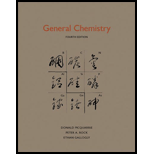
(a)
Interpretation:
Number of unpaired electrons present in ground state electronic configuration of
Concept Introduction:
Electrons of an atom are arranged in orbitals by the order of increasing energy. This arrangement is known as electronic configuration of atom. This can be represented using noble-gas shorthand notation also.
Ions are formed from neutral atom either by removal or addition of electrons from the valence shell.
Each orbital has two electrons and they both are in opposite spin. Electrons are filled up in the orbitals of a sub-shell by following Hund’s rule. This rule tells that all the orbitals are singly filled in a sub-shell and then the pairing occurs.
(a)
Explanation of Solution
Given ion is
The given
According to Hund’s rule, the electrons are added to the orbitals only after singly filling all the orbitals. After this takes place only the pairing of electrons is done. Therefore, the expansion of orbitals in the outermost shell is given as shown below.
Therefore, there are no unpaired electrons in
(b)
Interpretation:
Number of unpaired electrons present in ground state electronic configuration of
Concept Introduction:
Refer part (a).
(b)
Explanation of Solution
Given ion is
The given
According to Hund’s rule, the electrons are added to the orbitals only after singly filling all the orbitals. After this takes place only the pairing of electrons is done. Therefore, the expansion of orbitals in the outermost shell is given as shown below.
Therefore, there is one unpaired electrons in
(c)
Interpretation:
Number of unpaired electrons present in ground state electronic configuration of
Concept Introduction:
Refer part (a).
(c)
Explanation of Solution
Given ion is
The given
According to Hund’s rule, the electrons are added to the orbitals only after singly filling all the orbitals. After this takes place only the pairing of electrons is done. Therefore, the expansion of orbitals in the outermost shell is given as shown below.
Therefore, there is one unpaired electrons in
(d)
Interpretation:
Number of unpaired electrons present in ground state electronic configuration of
Concept Introduction:
Refer part (a).
(d)
Explanation of Solution
Given ion is
The given
According to Hund’s rule, the electrons are added to the orbitals only after singly filling all the orbitals. After this takes place only the pairing of electrons is done. Therefore, the expansion of orbitals in the outermost shell is given as shown below.
Therefore, there are no unpaired electrons in
(e)
Interpretation:
Number of unpaired electrons present in ground state electronic configuration of
Concept Introduction:
Refer part (a).
(e)
Explanation of Solution
Given ion is
The given
According to Hund’s rule, the electrons are added to the orbitals only after singly filling all the orbitals. After this takes place only the pairing of electrons is done. Therefore, the expansion of orbitals in the outermost shell is given as shown below.
Therefore, there are no unpaired electrons in
Want to see more full solutions like this?
Chapter 5 Solutions
General Chemistry
 ChemistryChemistryISBN:9781305957404Author:Steven S. Zumdahl, Susan A. Zumdahl, Donald J. DeCostePublisher:Cengage Learning
ChemistryChemistryISBN:9781305957404Author:Steven S. Zumdahl, Susan A. Zumdahl, Donald J. DeCostePublisher:Cengage Learning ChemistryChemistryISBN:9781259911156Author:Raymond Chang Dr., Jason Overby ProfessorPublisher:McGraw-Hill Education
ChemistryChemistryISBN:9781259911156Author:Raymond Chang Dr., Jason Overby ProfessorPublisher:McGraw-Hill Education Principles of Instrumental AnalysisChemistryISBN:9781305577213Author:Douglas A. Skoog, F. James Holler, Stanley R. CrouchPublisher:Cengage Learning
Principles of Instrumental AnalysisChemistryISBN:9781305577213Author:Douglas A. Skoog, F. James Holler, Stanley R. CrouchPublisher:Cengage Learning Organic ChemistryChemistryISBN:9780078021558Author:Janice Gorzynski Smith Dr.Publisher:McGraw-Hill Education
Organic ChemistryChemistryISBN:9780078021558Author:Janice Gorzynski Smith Dr.Publisher:McGraw-Hill Education Chemistry: Principles and ReactionsChemistryISBN:9781305079373Author:William L. Masterton, Cecile N. HurleyPublisher:Cengage Learning
Chemistry: Principles and ReactionsChemistryISBN:9781305079373Author:William L. Masterton, Cecile N. HurleyPublisher:Cengage Learning Elementary Principles of Chemical Processes, Bind...ChemistryISBN:9781118431221Author:Richard M. Felder, Ronald W. Rousseau, Lisa G. BullardPublisher:WILEY
Elementary Principles of Chemical Processes, Bind...ChemistryISBN:9781118431221Author:Richard M. Felder, Ronald W. Rousseau, Lisa G. BullardPublisher:WILEY





